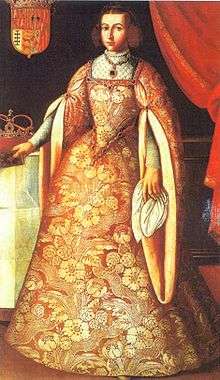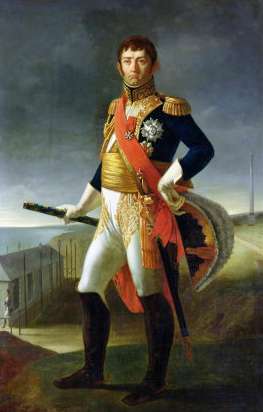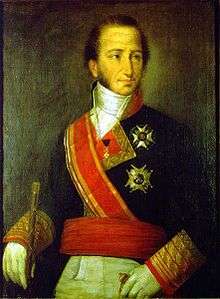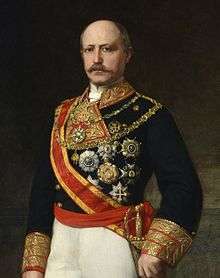List of Spanish regents
This is a list of Spanish regents, a regent, from the Latin regens "one who reigns", is a person selected to act as head of state (ruling or not) because the ruler is a minor, not present, or debilitated.[1]
Reign of Joanna, Queen of Castile and Aragon
| Image | Personal Coat of Arms |
Name | Regency start | Regency end |
|---|---|---|---|---|
| Regencies (Governor of the Realms), disability of Queen Joanna. | ||||
 |
.svg.png) |
Crown of Castile: Ferdinand II of Aragon |
26 November 1504 Death of Queen Isabella the Catholic. |
27 June 1506 Queen Joanna and King Philip I's arrival. |
 |
.svg.png) |
Crown of Castile: Ferdinand II of Aragon |
17 August 1507 Death of King Philip I of Castile. |
23 January 1516 |
.jpg) |
 |
Crown of Castile: Cardinal Francisco Jiménez de Cisneros |
23 January 1516 Death of King Ferdinand II. |
19 September 1517 King Charles I's arrival. |
 |
  |
Crown of Aragon: Alonso de Aragón Queen's Guardian and Germaine of Foix Lieutenant General |
23 January 1516 Death of King Ferdinand II. |
29 July 1518 Charles I become co-monarch with his mother Queen Joanna. |
Reign of Charles I
| Image | Personal Coat of Arms |
Name | Regency start | Regency end |
|---|---|---|---|---|
| Regencies (Governor of the Realms) during Charles I's absences.[2] | ||||
 |
 |
Cardinal Adriaan Florenszoon Boeyens | 1520 | 1522 King Charles I's arrival. |
 |
 |
Empress Isabella | 1529 | 1533 King Charles I's arrival. |
 |
 |
Empress Isabella | 1535 | 1536 King Charles I's arrival. |
 |
 |
Empress Isabella | 1538 | 1539 |
 |
.svg.png) |
Prince Philip[3] | 1539 Death of Empress Isabella. |
1541 King Charles I's arrival. |
 |
.svg.png) |
Prince Philip | 1543 | 1548 |
  |
.svg.png) .svg.png) |
Archduke Maximilian[4] and Maria of Austria |
1548 Charles I and Prince Philip's absences. |
1551 Prince Philip's arrival. |
 |
.svg.png) |
Prince Philip | 1551 | 1554 |
 |
 |
Joanna of Austria, Princess Dowager of Portugal | 1554 Charles I and Prince Philip's absences. |
1559 King Philip II's arrival. (Became monarch in 1556) |
Reign of Philip III
| Image | Name | Regency start | Regency end |
|---|---|---|---|
| Regency (Governor of the Realms) as President of the Council of Castile during King Philip III's visit to Portugal. | |||
.svg.png) |
Fernando de Acevedo | 22 April 1619 | 4 December 1619 |
Reign of Charles II
| Image | Personal Coat of Arms |
Name | Regency start | Regency end |
|---|---|---|---|---|
| Queen Regent during the minority of King Charles II. | ||||
 |
 |
Mariana of Austria | 17 September 1665 Death of King Philip IV.[5] |
6 November 1675 Charles II's majority.[6] |
| Regency (Lieutenant General of the Realms) during King Charles II's illness. | ||||
 |
.svg.png) |
Cardinal Luis Fernández de Portocarrero | 29 October 1700[7] | 1 November 1700 Death of King Charles II. |
Reign of Philip V
| Image | Name | Regency start | Regency end |
|---|---|---|---|
| Government Board of the Realms. | |||
-Common_Version.svg.png) |
|
1 November 1700 | 18 February 1701 King Philip V's arrival. |
| Image | Personal Coat of Arms |
Name | Regency start | Regency end |
|---|---|---|---|---|
| Regency (General Governor of the Realms) during King Philip V's absence. | ||||
 |
.svg.png) |
Cardinal Luis Fernández de Portocarrero | 1 September 1701[9] | 17 January 1703[10] |
Reign of Charles III
| Image | Personal Coat of Arms |
Name | Regency start | Regency end |
|---|---|---|---|---|
| Queen Regent during King Charles III's absence. | ||||
 |
 |
Elisabeth Farnese | 10 August 1759 Death of King Ferdinand VI. |
9 December 1759 King Charles III's arrival. |
First Reign of Ferdinand VII
| Image | Personal Coat of Arms |
Name | Regency start | Regency end |
|---|---|---|---|---|
| Supreme Board of Government, French invasion (King Ferdinand VII's absence). President: | ||||
 |
 |
Infante Antonio Pascual of Spain | 10 April 1808 | 4 May 1808 Infante Antonio Pascual's departure to Bayonne. |
French Invasion and Reign of Joseph Bonaparte
| Image | Personal Coat of Arms |
Name | Regency start | Regency end |
|---|---|---|---|---|
| Lieutenant General of the Realm. | ||||
 |
.svg.png) |
Joachim Murat | 4 May 1808[11] | 20 July 1808 King Joseph's arrival. |
| Image | Personal Coat of Arms |
Name | Regency start | Regency end |
|---|---|---|---|---|
| Emperor's Lieutenant General in Spain. | ||||
 |
.svg.png) |
Jean de Dieu Soult | 1 July 1813 King Joseph's departure.[12] |
11 December 1813 Treaty of Valençay |
Second Reign of Ferdinand VII
Peninsular War
| Regencies at Peninsular War, against the French invaders. | |||
| Image | Name | Regency start | Regency end |
|---|---|---|---|
| Supreme Central and Governing Board of the Realm. Presidents: | |||
 |
José Moñino, 1st Count of Floridablanca (Acting) |
25 September 1808 |
1 October 1808 |
| 1 October 1808 | 30 December 1808 | ||
 |
Vicente Joaquín Osorio de Moscoso y Guzmán, 15th Marquis of Astorga (Acting) |
30 December 1808 |
1 May 1809 |
1 May 1809 |
1 November 1809 | ||
.jpg) |
Juan Acisclo de Vera | 1 November 1809 | 31 January 1810 |
| Regency Board of Spain and the Indies. Presidents: | |||
.jpg) |
Francisco Javier Castaños | 1 February 1810 | 29 May 1810 |
 |
Pedro de Quevedo y Quintano | 29 May 1810 | 26 September 1810 |
.jpg) |
Francisco Saavedra de Sangronis | 27 September 1810 | 28 October 1810 |
_Golden_Fleece_Variant.svg.png) |
Pedro Agar y Bustillo | 28 October 1810 | 8 December 1810 |
 |
Joaquín Blake y Joyes | 8 December 1810 | 8 April 1811 |
_Golden_Fleece_Variant.svg.png) |
Pedro Agar y Bustillo | 8 April 1811 | 8 August 1811 |
_Golden_Fleece_Variant.svg.png) |
Gabriel de Císcar y Císcar | 8 August de 1811 | 8 December de 1811 |
_Golden_Fleece_Variant.svg.png) |
Pedro Agar y Bustillo | 8 December 1811 | 22 January 1812 |
| Regency Council of the Realm. Presidents: | |||
_Golden_Fleece_Variant.svg.png) |
Joaquín de Mosquera y Figueroa | 22 January 1812 | 15 June 1812 |
.jpg) |
Pedro de Alcántara Álvarez de Toledo, 13th Duke of the Infantado | 15 June 1812 | 15 December 1812 |
_Golden_Fleece_Variant.svg.png) |
Juan María de Villavicencio | 15 December 1812 | 8 March 1813 |
 |
Luis María de Borbón y Vallabriga, 14th Count of Chinchón (Acting) |
8 March 1813 |
22 March 1813 |
| 22 March 1813 | 10 May 1814 King Ferdinand VII's arrival. | ||
Liberal Triennium and Hundred Thousand Sons of St. Louis Intervention
| Regencies during the Hundred Thousand Sons of St. Louis Intervention. | |||
| Enshrined in the Cortes (Spanish Parliament) | |||
| Image | Name | Regency start | Regency end |
|---|---|---|---|
| Provisional Regency Council of the Realm. President: | |||
 |
Cayetano Valdés y Flores | 11 June 1823 King Ferdinand VII prisoner of the Cortes. |
15 June 1823 |
| Enshrined in the French army | |||
| Image | Name | Regency start | Regency end |
| Provisional Government Board of Spain and the Indies. President: | |||
 |
Francisco de Eguía | 9 April 1823 | 25 May 1823 |
| Regency Council of the Realm during King's Captivity. President: | |||
.jpg) |
Pedro de Alcántara Álvarez de Toledo, 13th Duke of the Infantado | 25 May 1823 | 1 October 1823 King Ferdinand VII's liberation. |
Reign of Isabella II
| Regencies during the minority of Queen Isabella II: | ||||
| Image | Personal Coat of Arms |
Name | Regency start | Regency end |
|---|---|---|---|---|
| Queen Regent | ||||
 |
 |
Maria Christina of the Two Sicilies | 29 September 1833 Death of King Ferdinand VII. |
12 October 1840 Queen Regent's deposition. |
| Provisional Regency of the Realm. President: | ||||
 |
 |
Baldomero Espartero | 12 October 1840 | 10 May 1841 |
| Regent of the Realm | ||||
 |
 |
Baldomero Espartero | 10 May 1841 | 23 July 1843 General Espartero's deposition and Queen Isabella II's majority. . |
Interregnum and Reign of Amadeo
| Image | Name | Term start | Term end |
|---|---|---|---|
| Provisional Government and Executive Power.[13] President: | |||
 |
Francisco Serrano y Domínguez | (President of the Provisional Government) 8 October 1868 Queen Isabella II's deposition. |
25 February 1869 |
| (President of the Executive Power) 25 February 1869 |
18 June 1869 | ||
| Image | Personal Coat of Arms |
Name | Regency start | Regency end |
|---|---|---|---|---|
| Regent of the Realm | ||||
 |
 |
Francisco Serrano y Domínguez | 18 June 1869 | 2 January 1871 King Amadeo's arrival. |
Reign of Alfonso XII
| Image | Name | Regency start | Regency end |
|---|---|---|---|
| Regency Ministry during King Alfonso XII's absence. President: | |||
 |
Antonio Cánovas del Castillo | 31 December 1874 Bourbon dynasty restored. |
14 January 1875 King Alfonso XII's arrival. |
Reigns of Maria de las Mercedes and Alfonso XIII
| Image | Personal Coat of Arms |
Name | Regency start | Regency end |
|---|---|---|---|---|
| Queen Regent during the minorities of Maria de las Mercedes, "Queen in Name" during her mother's pregnancy, and of King Alfonso XIII, who was born a king. | ||||
 |
 |
Maria Christina of Austria Death of King Alfonso XII. |
26 November 1885 | 17 May 1902 King Alfonso XIII's majority. |
Francoism
| Image | Coat of arms as head of state |
Name | Regency start | Regency end |
|---|---|---|---|---|
| President of the Regency Council during the notional interregnum under the Francoist regime. | ||||
 |
Francisco Franco, Caudillo of Spain | 26 July 1947 Restoration of the "Kingdom of Spain" |
20 November 1975 Died | |
.svg.png) |
Alejandro Rodríguez de Valcárcel | 20 November 1975 | 22 November 1975 Juan Carlos became monarch. | |
Acting regents
| Image | Name | Regency start | Regency end | |
|---|---|---|---|---|
| Regency Council during Francisco Franco's visit to Portugal. | ||||
.svg.png) |
|
22 October 1949 | 27 October 1949 | |
| Image | Personal Coat of arms |
Name | Regency start | Regency end |
|---|---|---|---|---|
| Acting Head of State during Francisco Franco's illness. | ||||
 |
 |
Juan Carlos, Prince of Spain | 19 July 1974 |
2 September 1974 |
| 30 October 1975 | 20 November 1975 Death of Francisco Franco. | |||
See also
- Regency
- List of regents
- List of heads of state of Spain
- List of Spanish monarchs
- President of Spain
- Royal Consorts of Spain
- Prime Minister of Spain
- Spanish monarchy
- Kings of Spain family tree
Notes and references
- ↑ The Oxford English Dictionary defines the term as "A person appointed to administer a State because the Monarch is a minor, is absent or is incapacitated."
- ↑ Pernot, François (2003), La Franche-Comté espagnole: à travers les archives de Simancas, une autre histoire des Franc-Comtois et de leurs relations avec l'Espagne de 1493 à 1678, ed. Presses Universitaires de Franche-Comté, pág.32 (French)
- ↑ Los viajes del emperador, Manuel de Foronda y Aguilera (1914). (Spanish)
- ↑ Los viajes del emperador, Manuel de Foronda y Aguilera (1914)(Spanish)
- ↑ Testamento de Felipe IV, incluido en la "Coleccion de los tratados (...) hechos por los pueblos, reyes y príncipes de España", vol. VII, págs. 678-718, de José Antonio de Abreu y Bertodano.(Spanish)
- ↑ Gaceta de Madrid, 9 de noviembre de 1700 (Spanish).
- ↑ Decreto de Carlos II, 29 de octubre de 1700 (Spanish).
- ↑ Gaceta de Madrid, 2 de noviembre de 1700 (Spanish).
- ↑ Gaceta de Madrid, 6 de septiembre de 1701 (Spanish).
- ↑ Gaceta de Madrid, 23 de enero de 1703 (Spanish)
- ↑ Gaceta de Madrid, 13 de mayo 1808 (Spanish)
- ↑ (Spanish).
- ↑ The official name of " Executive Power " between 1868 and 1874, designates a transitory and undefined authority without a constitutional configuration.
- ↑ BOE 21 october 1949 (Spanish)
This article is issued from Wikipedia - version of the Saturday, October 17, 2015. The text is available under the Creative Commons Attribution/Share Alike but additional terms may apply for the media files.